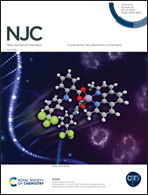Effects of anchoring and spacer groups of asymmetric zinc phthalocyanines on the photovoltaic performance of dye-sensitized solar cells†
Abstract
In this study, we aim to change the number of anchoring groups and their spacers on zinc(II) phthalocyanine (ZnPc) rings to improve the performance of ZnPcs used as photosensitizers in dye-sensitized solar cells (DSSCs). For this purpose, two new A3B type asymmetric ZnPcs are achieved using a statistical condensation method with a different number of 2,4-di-tert-butyl-6-(3,4-dicyanophenoxy)benzoic acid, 4-(2,4-di-tert-butylphenoxy), and 4-(6-carboxy-2-naphthoxy) moieties on the peripheral positions of Pc rings. The structures of these novel asymmetric phthalocyanines were elucidated by spectroscopic methods such as elemental analysis, MALDI-TOF MS, 1H-NMR, FT-IR, and UV-Vis, and then electrochemical analysis. The electrochemical data show that both ZnPcs undergo one oxidation and three reduction reactions whose positions are slightly altered with the substituents' different electron-releasing/withdrawing features. In situ spectroelectrochemical results are used to assign the electron transfer reactions to the Pc-based processes of both ZnPcs. The positions of the highest occupied molecular orbital (HOMO) and the lowest unoccupied molecular orbital (LUMO) which are derived from the first reduction and oxidation couples indicate their appropriateness as photosensitizers in DSSCs. The photovoltaic data indicate the significant role of the nature of the spacer groups and the number of anchoring groups in the electron transfer from the photo-excited ZnPcs into the semiconductor on the anode of the DSSC, which enhances the efficiency of the DSSC. ZnPc(6) bearing three benzoic acid and naphthoic acid anchoring groups, three benzene spacers and one naphthalene spacer exhibits higher open circuit potential (VOC) (760 mV), current density (JSC) (9.97 mA cm−2) and FF (41%), incident monochromatic photon-to-current conversion efficiency (IPCE) (50%), and power conversion efficiency (η) (2.97%), than ZnPc(7) bearing three benzoic acid anchoring groups and three benzene spacers.



 Please wait while we load your content...
Please wait while we load your content...